Corporate Social Responsibility and Greenhouse Gas Emission Analysis
VerifiedAdded on 2022/09/02
|15
|3755
|20
Report
AI Summary
This report delves into the critical issue of greenhouse gas emissions from a corporate social responsibility perspective. It begins by establishing the historical context of the issue, tracing its development from early scientific observations to the present day, highlighting the role of industrialization and deforestation. The report then explores the ethical theories and sustainability concepts that underpin the need for businesses to address emissions, including utilitarian ethics, corporate social responsibility models like Archie Carroll's framework and the triple bottom line, and the importance of sustainability. It examines international efforts such as the Kyoto Protocol and the Paris Agreement, detailing how these initiatives influence corporate practices and the adoption of science-based targets. The report concludes with specific recommendations for companies to reduce their environmental impact, such as waste management and energy-efficient lighting, emphasizing the importance of businesses taking responsibility for their environmental footprint.

Running Head: BUSINESS AND CORPORATION LAW 0
Corporate Social Responsibility
1/3/2020
Student’s Name
Corporate Social Responsibility
1/3/2020
Student’s Name
Paraphrase This Document
Need a fresh take? Get an instant paraphrase of this document with our AI Paraphraser
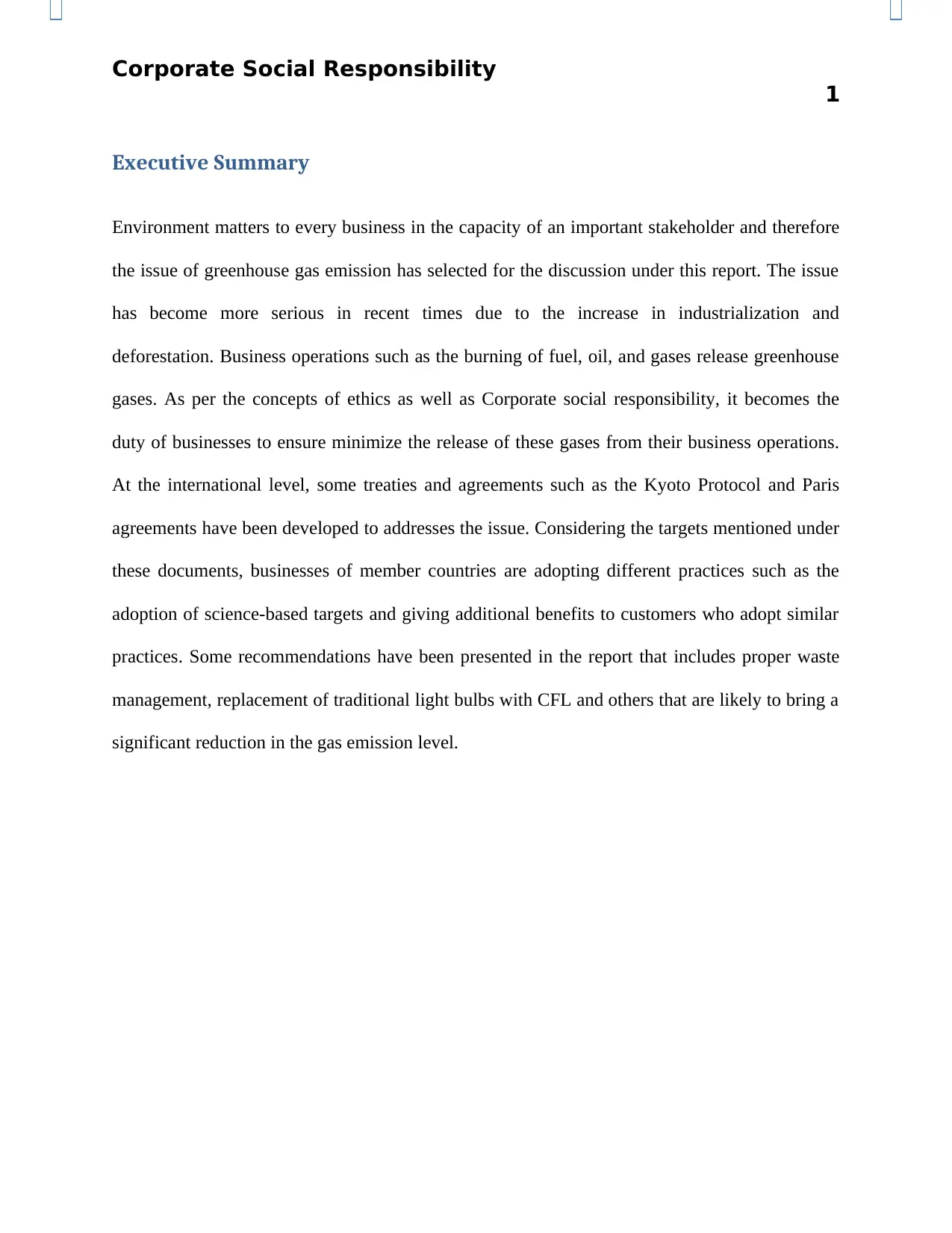
Corporate Social Responsibility
1
Executive Summary
Environment matters to every business in the capacity of an important stakeholder and therefore
the issue of greenhouse gas emission has selected for the discussion under this report. The issue
has become more serious in recent times due to the increase in industrialization and
deforestation. Business operations such as the burning of fuel, oil, and gases release greenhouse
gases. As per the concepts of ethics as well as Corporate social responsibility, it becomes the
duty of businesses to ensure minimize the release of these gases from their business operations.
At the international level, some treaties and agreements such as the Kyoto Protocol and Paris
agreements have been developed to addresses the issue. Considering the targets mentioned under
these documents, businesses of member countries are adopting different practices such as the
adoption of science-based targets and giving additional benefits to customers who adopt similar
practices. Some recommendations have been presented in the report that includes proper waste
management, replacement of traditional light bulbs with CFL and others that are likely to bring a
significant reduction in the gas emission level.
1
Executive Summary
Environment matters to every business in the capacity of an important stakeholder and therefore
the issue of greenhouse gas emission has selected for the discussion under this report. The issue
has become more serious in recent times due to the increase in industrialization and
deforestation. Business operations such as the burning of fuel, oil, and gases release greenhouse
gases. As per the concepts of ethics as well as Corporate social responsibility, it becomes the
duty of businesses to ensure minimize the release of these gases from their business operations.
At the international level, some treaties and agreements such as the Kyoto Protocol and Paris
agreements have been developed to addresses the issue. Considering the targets mentioned under
these documents, businesses of member countries are adopting different practices such as the
adoption of science-based targets and giving additional benefits to customers who adopt similar
practices. Some recommendations have been presented in the report that includes proper waste
management, replacement of traditional light bulbs with CFL and others that are likely to bring a
significant reduction in the gas emission level.
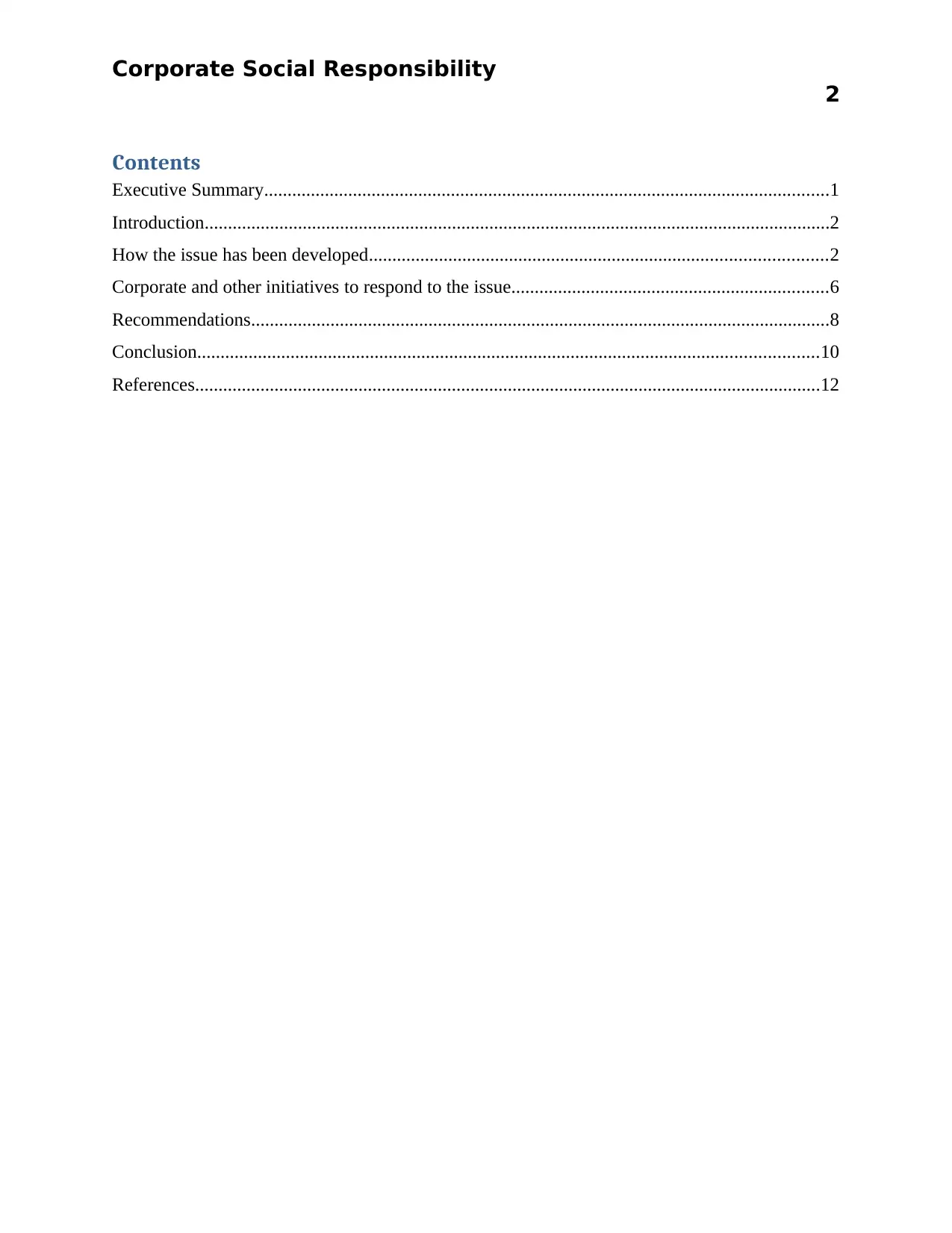
Corporate Social Responsibility
2
Contents
Executive Summary.........................................................................................................................1
Introduction......................................................................................................................................2
How the issue has been developed..................................................................................................2
Corporate and other initiatives to respond to the issue....................................................................6
Recommendations............................................................................................................................8
Conclusion.....................................................................................................................................10
References......................................................................................................................................12
2
Contents
Executive Summary.........................................................................................................................1
Introduction......................................................................................................................................2
How the issue has been developed..................................................................................................2
Corporate and other initiatives to respond to the issue....................................................................6
Recommendations............................................................................................................................8
Conclusion.....................................................................................................................................10
References......................................................................................................................................12
⊘ This is a preview!⊘
Do you want full access?
Subscribe today to unlock all pages.

Trusted by 1+ million students worldwide
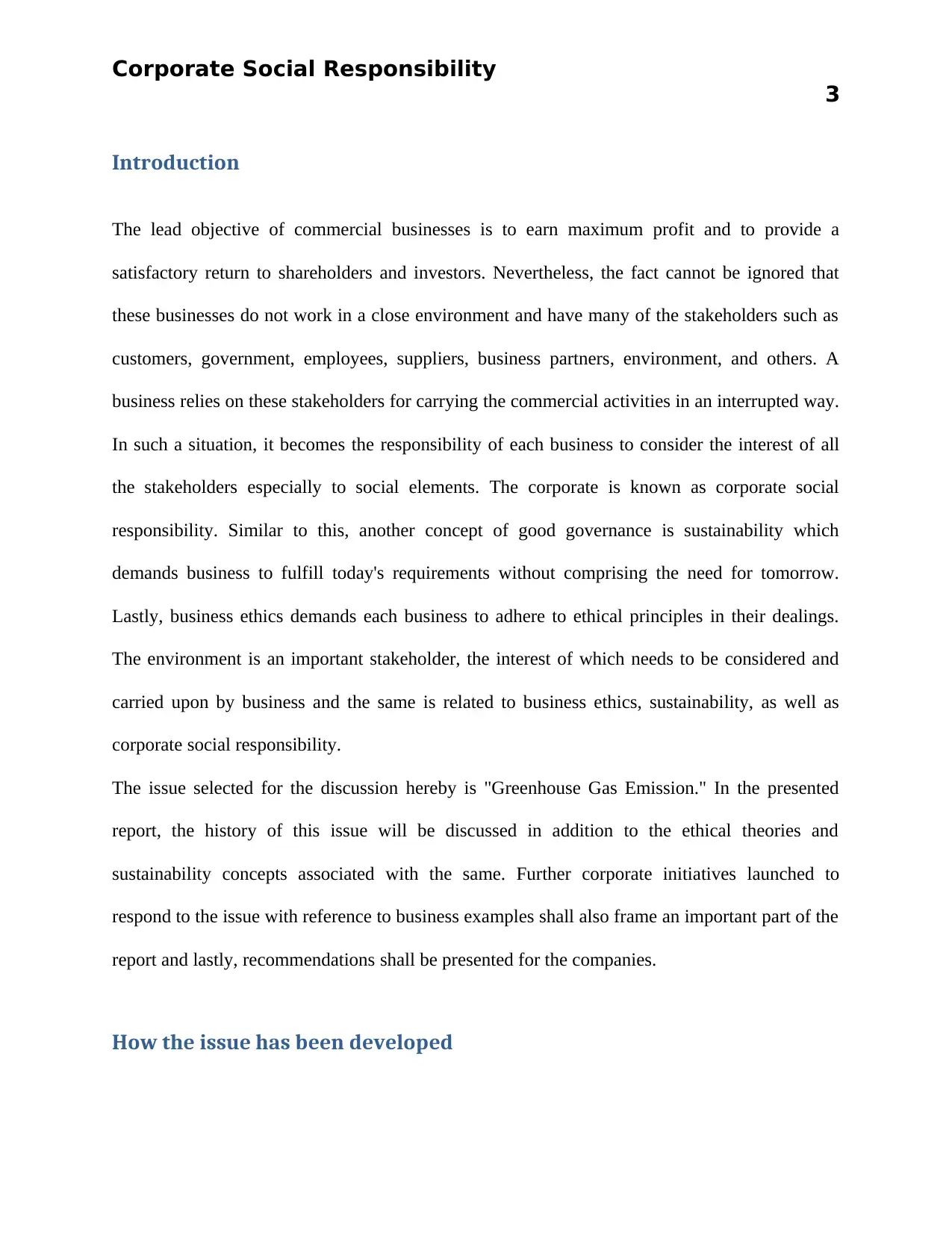
Corporate Social Responsibility
3
Introduction
The lead objective of commercial businesses is to earn maximum profit and to provide a
satisfactory return to shareholders and investors. Nevertheless, the fact cannot be ignored that
these businesses do not work in a close environment and have many of the stakeholders such as
customers, government, employees, suppliers, business partners, environment, and others. A
business relies on these stakeholders for carrying the commercial activities in an interrupted way.
In such a situation, it becomes the responsibility of each business to consider the interest of all
the stakeholders especially to social elements. The corporate is known as corporate social
responsibility. Similar to this, another concept of good governance is sustainability which
demands business to fulfill today's requirements without comprising the need for tomorrow.
Lastly, business ethics demands each business to adhere to ethical principles in their dealings.
The environment is an important stakeholder, the interest of which needs to be considered and
carried upon by business and the same is related to business ethics, sustainability, as well as
corporate social responsibility.
The issue selected for the discussion hereby is "Greenhouse Gas Emission." In the presented
report, the history of this issue will be discussed in addition to the ethical theories and
sustainability concepts associated with the same. Further corporate initiatives launched to
respond to the issue with reference to business examples shall also frame an important part of the
report and lastly, recommendations shall be presented for the companies.
How the issue has been developed
3
Introduction
The lead objective of commercial businesses is to earn maximum profit and to provide a
satisfactory return to shareholders and investors. Nevertheless, the fact cannot be ignored that
these businesses do not work in a close environment and have many of the stakeholders such as
customers, government, employees, suppliers, business partners, environment, and others. A
business relies on these stakeholders for carrying the commercial activities in an interrupted way.
In such a situation, it becomes the responsibility of each business to consider the interest of all
the stakeholders especially to social elements. The corporate is known as corporate social
responsibility. Similar to this, another concept of good governance is sustainability which
demands business to fulfill today's requirements without comprising the need for tomorrow.
Lastly, business ethics demands each business to adhere to ethical principles in their dealings.
The environment is an important stakeholder, the interest of which needs to be considered and
carried upon by business and the same is related to business ethics, sustainability, as well as
corporate social responsibility.
The issue selected for the discussion hereby is "Greenhouse Gas Emission." In the presented
report, the history of this issue will be discussed in addition to the ethical theories and
sustainability concepts associated with the same. Further corporate initiatives launched to
respond to the issue with reference to business examples shall also frame an important part of the
report and lastly, recommendations shall be presented for the companies.
How the issue has been developed
Paraphrase This Document
Need a fresh take? Get an instant paraphrase of this document with our AI Paraphraser
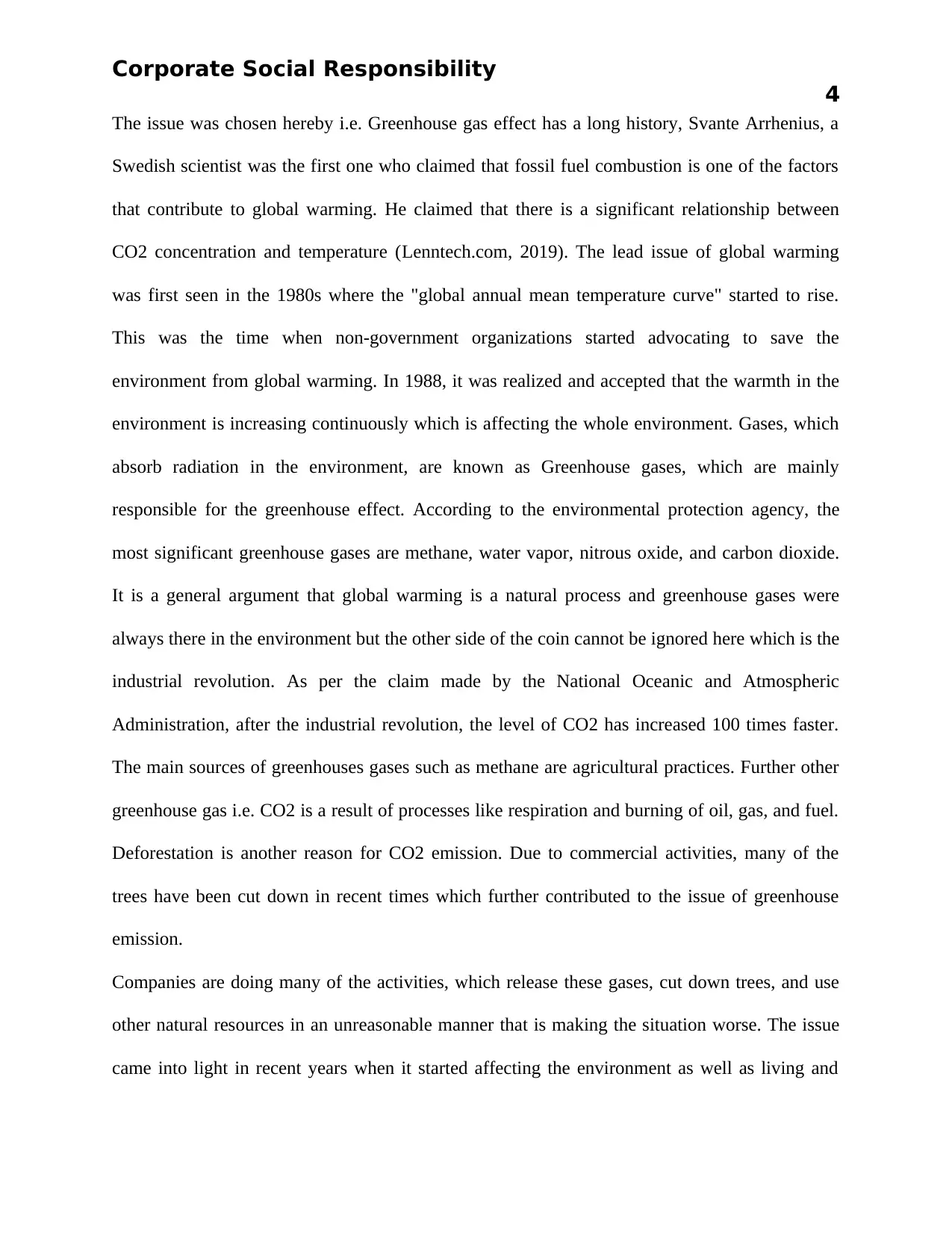
Corporate Social Responsibility
4
The issue was chosen hereby i.e. Greenhouse gas effect has a long history, Svante Arrhenius, a
Swedish scientist was the first one who claimed that fossil fuel combustion is one of the factors
that contribute to global warming. He claimed that there is a significant relationship between
CO2 concentration and temperature (Lenntech.com, 2019). The lead issue of global warming
was first seen in the 1980s where the "global annual mean temperature curve" started to rise.
This was the time when non-government organizations started advocating to save the
environment from global warming. In 1988, it was realized and accepted that the warmth in the
environment is increasing continuously which is affecting the whole environment. Gases, which
absorb radiation in the environment, are known as Greenhouse gases, which are mainly
responsible for the greenhouse effect. According to the environmental protection agency, the
most significant greenhouse gases are methane, water vapor, nitrous oxide, and carbon dioxide.
It is a general argument that global warming is a natural process and greenhouse gases were
always there in the environment but the other side of the coin cannot be ignored here which is the
industrial revolution. As per the claim made by the National Oceanic and Atmospheric
Administration, after the industrial revolution, the level of CO2 has increased 100 times faster.
The main sources of greenhouses gases such as methane are agricultural practices. Further other
greenhouse gas i.e. CO2 is a result of processes like respiration and burning of oil, gas, and fuel.
Deforestation is another reason for CO2 emission. Due to commercial activities, many of the
trees have been cut down in recent times which further contributed to the issue of greenhouse
emission.
Companies are doing many of the activities, which release these gases, cut down trees, and use
other natural resources in an unreasonable manner that is making the situation worse. The issue
came into light in recent years when it started affecting the environment as well as living and
4
The issue was chosen hereby i.e. Greenhouse gas effect has a long history, Svante Arrhenius, a
Swedish scientist was the first one who claimed that fossil fuel combustion is one of the factors
that contribute to global warming. He claimed that there is a significant relationship between
CO2 concentration and temperature (Lenntech.com, 2019). The lead issue of global warming
was first seen in the 1980s where the "global annual mean temperature curve" started to rise.
This was the time when non-government organizations started advocating to save the
environment from global warming. In 1988, it was realized and accepted that the warmth in the
environment is increasing continuously which is affecting the whole environment. Gases, which
absorb radiation in the environment, are known as Greenhouse gases, which are mainly
responsible for the greenhouse effect. According to the environmental protection agency, the
most significant greenhouse gases are methane, water vapor, nitrous oxide, and carbon dioxide.
It is a general argument that global warming is a natural process and greenhouse gases were
always there in the environment but the other side of the coin cannot be ignored here which is the
industrial revolution. As per the claim made by the National Oceanic and Atmospheric
Administration, after the industrial revolution, the level of CO2 has increased 100 times faster.
The main sources of greenhouses gases such as methane are agricultural practices. Further other
greenhouse gas i.e. CO2 is a result of processes like respiration and burning of oil, gas, and fuel.
Deforestation is another reason for CO2 emission. Due to commercial activities, many of the
trees have been cut down in recent times which further contributed to the issue of greenhouse
emission.
Companies are doing many of the activities, which release these gases, cut down trees, and use
other natural resources in an unreasonable manner that is making the situation worse. The issue
came into light in recent years when it started affecting the environment as well as living and
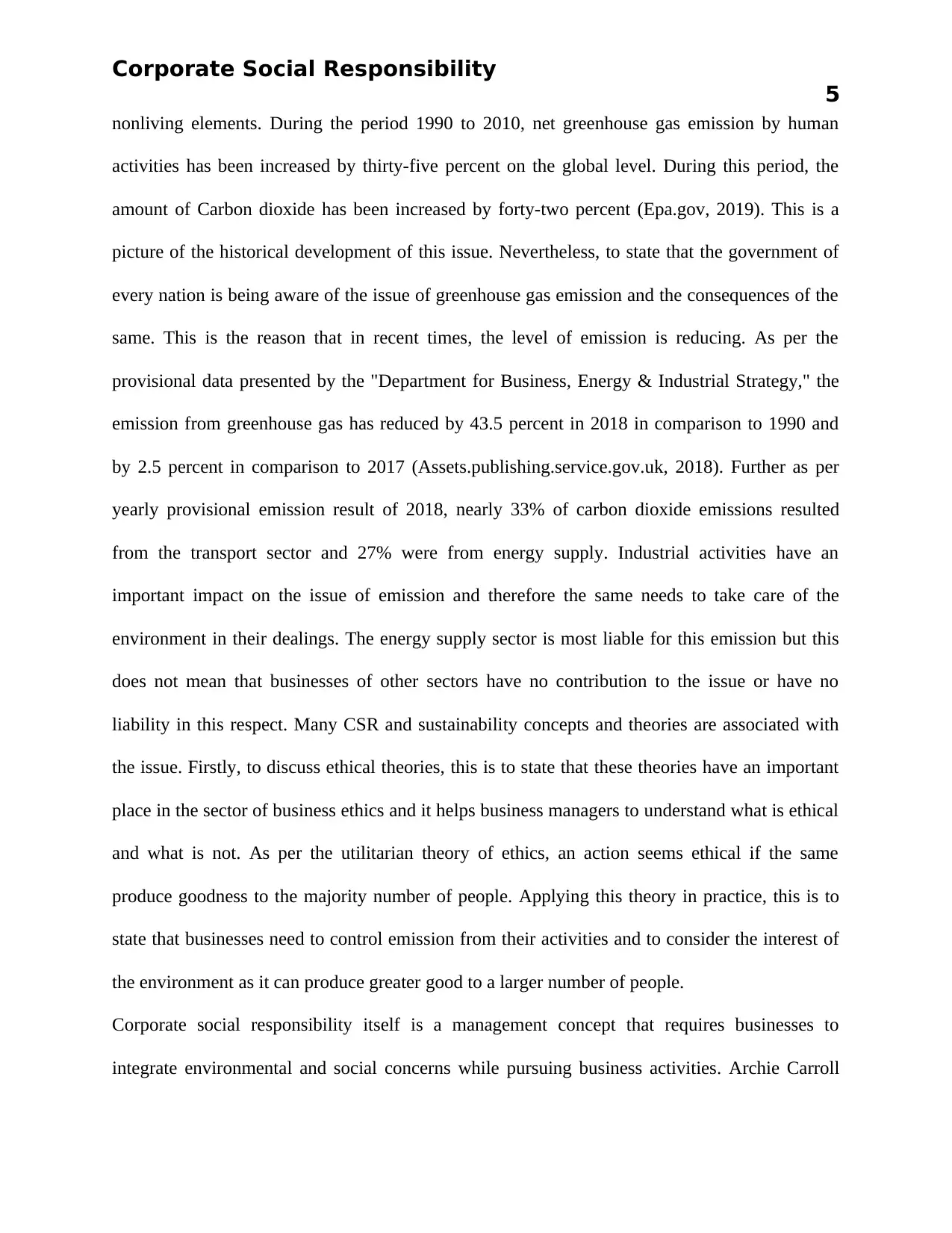
Corporate Social Responsibility
5
nonliving elements. During the period 1990 to 2010, net greenhouse gas emission by human
activities has been increased by thirty-five percent on the global level. During this period, the
amount of Carbon dioxide has been increased by forty-two percent (Epa.gov, 2019). This is a
picture of the historical development of this issue. Nevertheless, to state that the government of
every nation is being aware of the issue of greenhouse gas emission and the consequences of the
same. This is the reason that in recent times, the level of emission is reducing. As per the
provisional data presented by the "Department for Business, Energy & Industrial Strategy," the
emission from greenhouse gas has reduced by 43.5 percent in 2018 in comparison to 1990 and
by 2.5 percent in comparison to 2017 (Assets.publishing.service.gov.uk, 2018). Further as per
yearly provisional emission result of 2018, nearly 33% of carbon dioxide emissions resulted
from the transport sector and 27% were from energy supply. Industrial activities have an
important impact on the issue of emission and therefore the same needs to take care of the
environment in their dealings. The energy supply sector is most liable for this emission but this
does not mean that businesses of other sectors have no contribution to the issue or have no
liability in this respect. Many CSR and sustainability concepts and theories are associated with
the issue. Firstly, to discuss ethical theories, this is to state that these theories have an important
place in the sector of business ethics and it helps business managers to understand what is ethical
and what is not. As per the utilitarian theory of ethics, an action seems ethical if the same
produce goodness to the majority number of people. Applying this theory in practice, this is to
state that businesses need to control emission from their activities and to consider the interest of
the environment as it can produce greater good to a larger number of people.
Corporate social responsibility itself is a management concept that requires businesses to
integrate environmental and social concerns while pursuing business activities. Archie Carroll
5
nonliving elements. During the period 1990 to 2010, net greenhouse gas emission by human
activities has been increased by thirty-five percent on the global level. During this period, the
amount of Carbon dioxide has been increased by forty-two percent (Epa.gov, 2019). This is a
picture of the historical development of this issue. Nevertheless, to state that the government of
every nation is being aware of the issue of greenhouse gas emission and the consequences of the
same. This is the reason that in recent times, the level of emission is reducing. As per the
provisional data presented by the "Department for Business, Energy & Industrial Strategy," the
emission from greenhouse gas has reduced by 43.5 percent in 2018 in comparison to 1990 and
by 2.5 percent in comparison to 2017 (Assets.publishing.service.gov.uk, 2018). Further as per
yearly provisional emission result of 2018, nearly 33% of carbon dioxide emissions resulted
from the transport sector and 27% were from energy supply. Industrial activities have an
important impact on the issue of emission and therefore the same needs to take care of the
environment in their dealings. The energy supply sector is most liable for this emission but this
does not mean that businesses of other sectors have no contribution to the issue or have no
liability in this respect. Many CSR and sustainability concepts and theories are associated with
the issue. Firstly, to discuss ethical theories, this is to state that these theories have an important
place in the sector of business ethics and it helps business managers to understand what is ethical
and what is not. As per the utilitarian theory of ethics, an action seems ethical if the same
produce goodness to the majority number of people. Applying this theory in practice, this is to
state that businesses need to control emission from their activities and to consider the interest of
the environment as it can produce greater good to a larger number of people.
Corporate social responsibility itself is a management concept that requires businesses to
integrate environmental and social concerns while pursuing business activities. Archie Carroll
⊘ This is a preview!⊘
Do you want full access?
Subscribe today to unlock all pages.

Trusted by 1+ million students worldwide
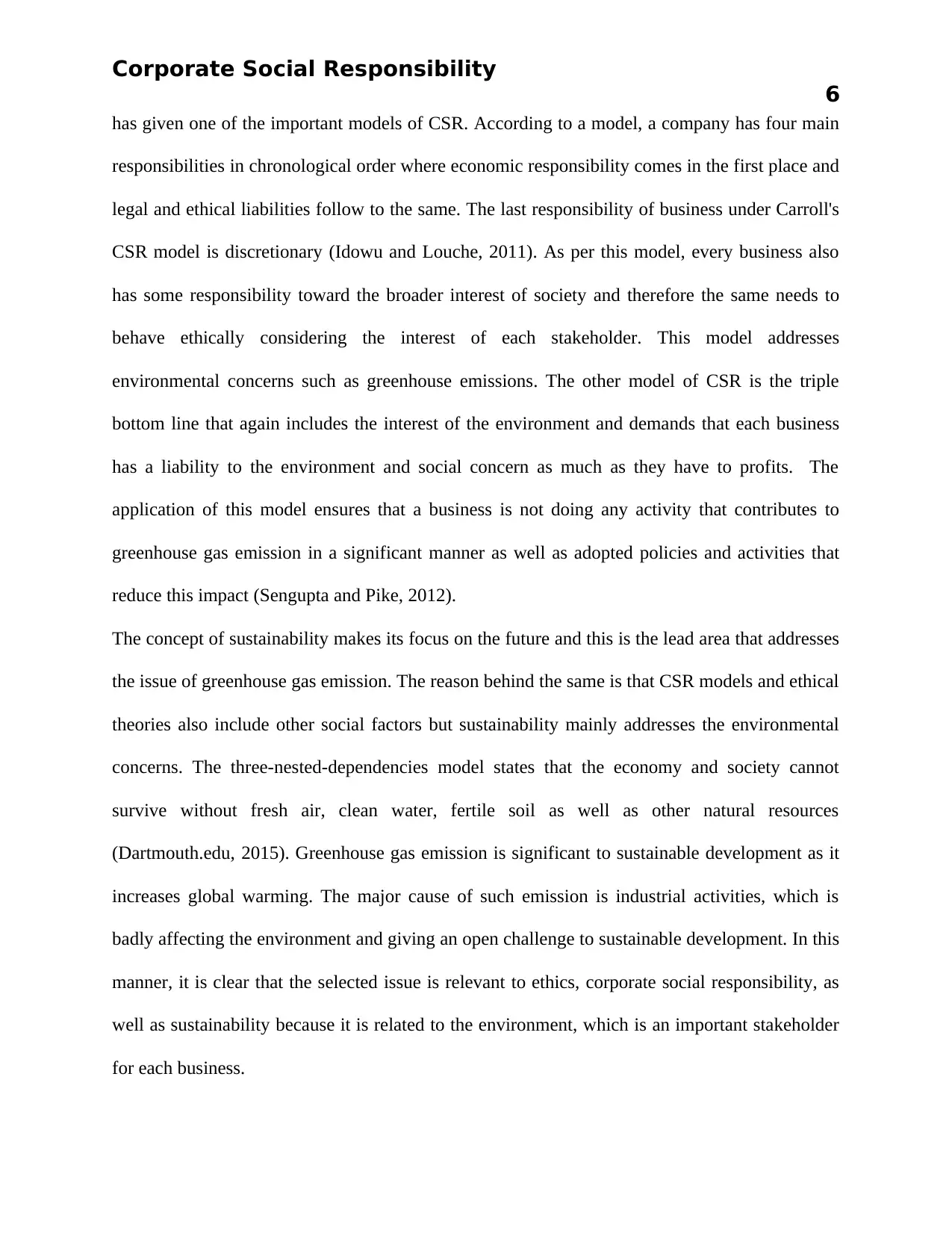
Corporate Social Responsibility
6
has given one of the important models of CSR. According to a model, a company has four main
responsibilities in chronological order where economic responsibility comes in the first place and
legal and ethical liabilities follow to the same. The last responsibility of business under Carroll's
CSR model is discretionary (Idowu and Louche, 2011). As per this model, every business also
has some responsibility toward the broader interest of society and therefore the same needs to
behave ethically considering the interest of each stakeholder. This model addresses
environmental concerns such as greenhouse emissions. The other model of CSR is the triple
bottom line that again includes the interest of the environment and demands that each business
has a liability to the environment and social concern as much as they have to profits. The
application of this model ensures that a business is not doing any activity that contributes to
greenhouse gas emission in a significant manner as well as adopted policies and activities that
reduce this impact (Sengupta and Pike, 2012).
The concept of sustainability makes its focus on the future and this is the lead area that addresses
the issue of greenhouse gas emission. The reason behind the same is that CSR models and ethical
theories also include other social factors but sustainability mainly addresses the environmental
concerns. The three-nested-dependencies model states that the economy and society cannot
survive without fresh air, clean water, fertile soil as well as other natural resources
(Dartmouth.edu, 2015). Greenhouse gas emission is significant to sustainable development as it
increases global warming. The major cause of such emission is industrial activities, which is
badly affecting the environment and giving an open challenge to sustainable development. In this
manner, it is clear that the selected issue is relevant to ethics, corporate social responsibility, as
well as sustainability because it is related to the environment, which is an important stakeholder
for each business.
6
has given one of the important models of CSR. According to a model, a company has four main
responsibilities in chronological order where economic responsibility comes in the first place and
legal and ethical liabilities follow to the same. The last responsibility of business under Carroll's
CSR model is discretionary (Idowu and Louche, 2011). As per this model, every business also
has some responsibility toward the broader interest of society and therefore the same needs to
behave ethically considering the interest of each stakeholder. This model addresses
environmental concerns such as greenhouse emissions. The other model of CSR is the triple
bottom line that again includes the interest of the environment and demands that each business
has a liability to the environment and social concern as much as they have to profits. The
application of this model ensures that a business is not doing any activity that contributes to
greenhouse gas emission in a significant manner as well as adopted policies and activities that
reduce this impact (Sengupta and Pike, 2012).
The concept of sustainability makes its focus on the future and this is the lead area that addresses
the issue of greenhouse gas emission. The reason behind the same is that CSR models and ethical
theories also include other social factors but sustainability mainly addresses the environmental
concerns. The three-nested-dependencies model states that the economy and society cannot
survive without fresh air, clean water, fertile soil as well as other natural resources
(Dartmouth.edu, 2015). Greenhouse gas emission is significant to sustainable development as it
increases global warming. The major cause of such emission is industrial activities, which is
badly affecting the environment and giving an open challenge to sustainable development. In this
manner, it is clear that the selected issue is relevant to ethics, corporate social responsibility, as
well as sustainability because it is related to the environment, which is an important stakeholder
for each business.
Paraphrase This Document
Need a fresh take? Get an instant paraphrase of this document with our AI Paraphraser
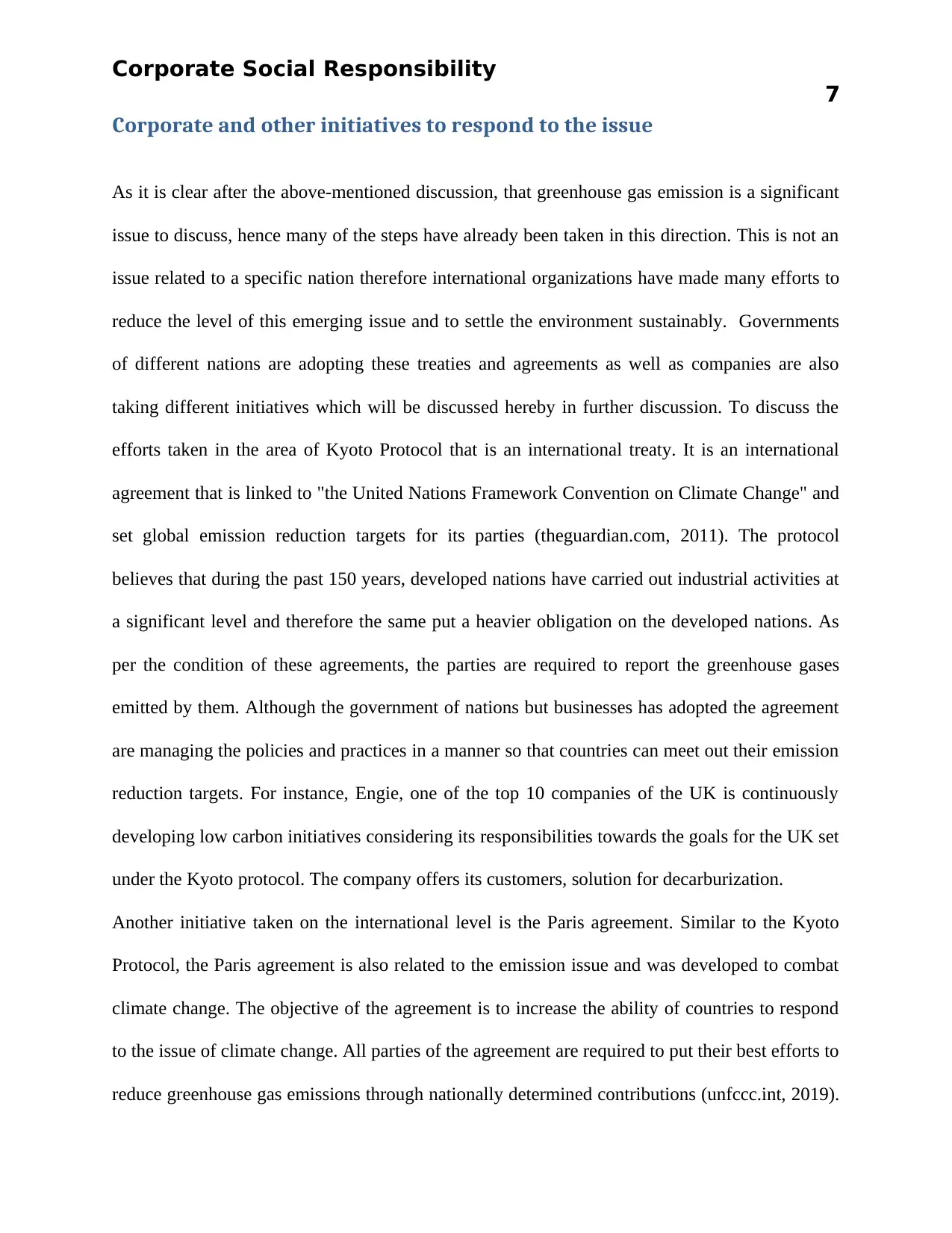
Corporate Social Responsibility
7
Corporate and other initiatives to respond to the issue
As it is clear after the above-mentioned discussion, that greenhouse gas emission is a significant
issue to discuss, hence many of the steps have already been taken in this direction. This is not an
issue related to a specific nation therefore international organizations have made many efforts to
reduce the level of this emerging issue and to settle the environment sustainably. Governments
of different nations are adopting these treaties and agreements as well as companies are also
taking different initiatives which will be discussed hereby in further discussion. To discuss the
efforts taken in the area of Kyoto Protocol that is an international treaty. It is an international
agreement that is linked to "the United Nations Framework Convention on Climate Change" and
set global emission reduction targets for its parties (theguardian.com, 2011). The protocol
believes that during the past 150 years, developed nations have carried out industrial activities at
a significant level and therefore the same put a heavier obligation on the developed nations. As
per the condition of these agreements, the parties are required to report the greenhouse gases
emitted by them. Although the government of nations but businesses has adopted the agreement
are managing the policies and practices in a manner so that countries can meet out their emission
reduction targets. For instance, Engie, one of the top 10 companies of the UK is continuously
developing low carbon initiatives considering its responsibilities towards the goals for the UK set
under the Kyoto protocol. The company offers its customers, solution for decarburization.
Another initiative taken on the international level is the Paris agreement. Similar to the Kyoto
Protocol, the Paris agreement is also related to the emission issue and was developed to combat
climate change. The objective of the agreement is to increase the ability of countries to respond
to the issue of climate change. All parties of the agreement are required to put their best efforts to
reduce greenhouse gas emissions through nationally determined contributions (unfccc.int, 2019).
7
Corporate and other initiatives to respond to the issue
As it is clear after the above-mentioned discussion, that greenhouse gas emission is a significant
issue to discuss, hence many of the steps have already been taken in this direction. This is not an
issue related to a specific nation therefore international organizations have made many efforts to
reduce the level of this emerging issue and to settle the environment sustainably. Governments
of different nations are adopting these treaties and agreements as well as companies are also
taking different initiatives which will be discussed hereby in further discussion. To discuss the
efforts taken in the area of Kyoto Protocol that is an international treaty. It is an international
agreement that is linked to "the United Nations Framework Convention on Climate Change" and
set global emission reduction targets for its parties (theguardian.com, 2011). The protocol
believes that during the past 150 years, developed nations have carried out industrial activities at
a significant level and therefore the same put a heavier obligation on the developed nations. As
per the condition of these agreements, the parties are required to report the greenhouse gases
emitted by them. Although the government of nations but businesses has adopted the agreement
are managing the policies and practices in a manner so that countries can meet out their emission
reduction targets. For instance, Engie, one of the top 10 companies of the UK is continuously
developing low carbon initiatives considering its responsibilities towards the goals for the UK set
under the Kyoto protocol. The company offers its customers, solution for decarburization.
Another initiative taken on the international level is the Paris agreement. Similar to the Kyoto
Protocol, the Paris agreement is also related to the emission issue and was developed to combat
climate change. The objective of the agreement is to increase the ability of countries to respond
to the issue of climate change. All parties of the agreement are required to put their best efforts to
reduce greenhouse gas emissions through nationally determined contributions (unfccc.int, 2019).
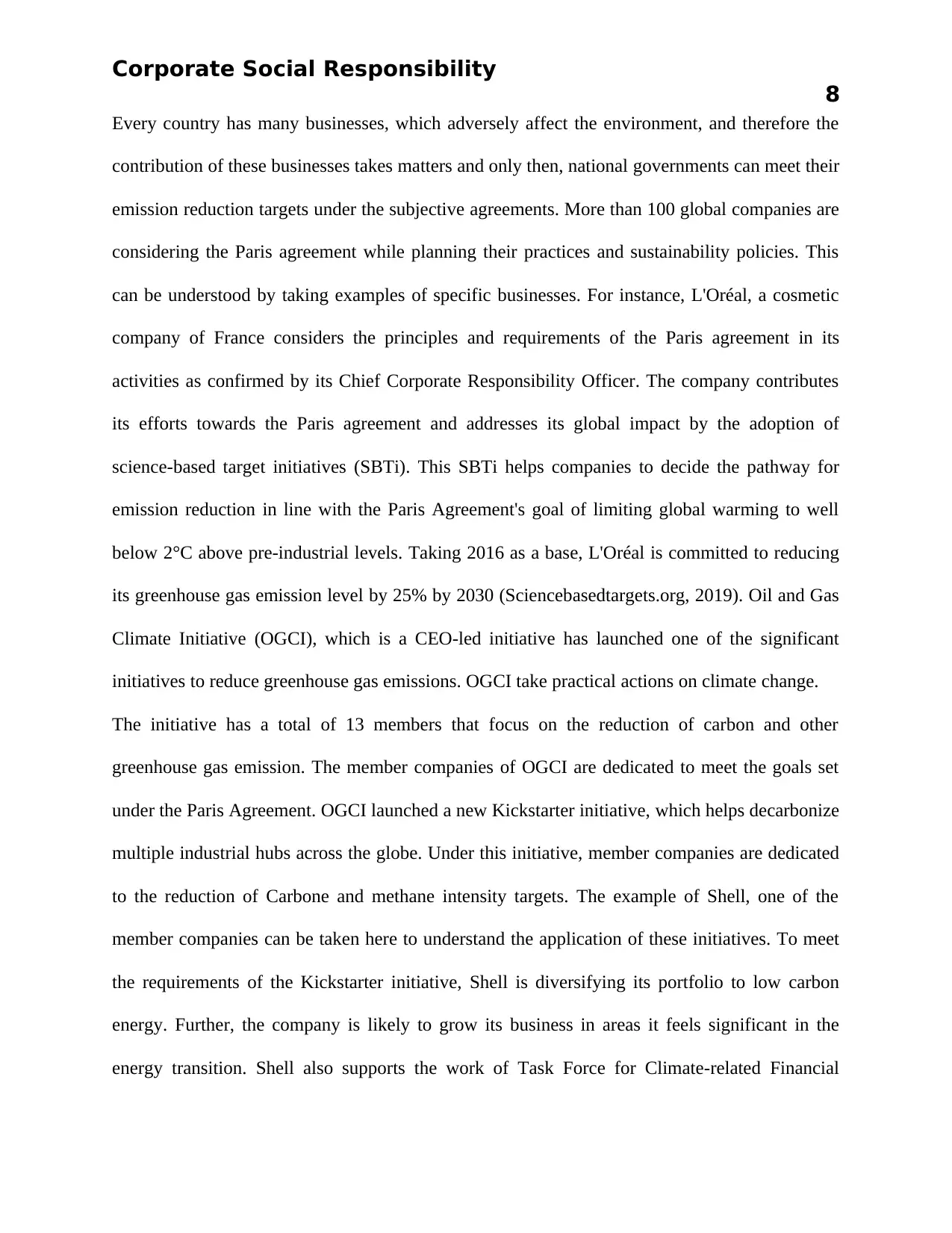
Corporate Social Responsibility
8
Every country has many businesses, which adversely affect the environment, and therefore the
contribution of these businesses takes matters and only then, national governments can meet their
emission reduction targets under the subjective agreements. More than 100 global companies are
considering the Paris agreement while planning their practices and sustainability policies. This
can be understood by taking examples of specific businesses. For instance, L'Oréal, a cosmetic
company of France considers the principles and requirements of the Paris agreement in its
activities as confirmed by its Chief Corporate Responsibility Officer. The company contributes
its efforts towards the Paris agreement and addresses its global impact by the adoption of
science-based target initiatives (SBTi). This SBTi helps companies to decide the pathway for
emission reduction in line with the Paris Agreement's goal of limiting global warming to well
below 2°C above pre-industrial levels. Taking 2016 as a base, L'Oréal is committed to reducing
its greenhouse gas emission level by 25% by 2030 (Sciencebasedtargets.org, 2019). Oil and Gas
Climate Initiative (OGCI), which is a CEO-led initiative has launched one of the significant
initiatives to reduce greenhouse gas emissions. OGCI take practical actions on climate change.
The initiative has a total of 13 members that focus on the reduction of carbon and other
greenhouse gas emission. The member companies of OGCI are dedicated to meet the goals set
under the Paris Agreement. OGCI launched a new Kickstarter initiative, which helps decarbonize
multiple industrial hubs across the globe. Under this initiative, member companies are dedicated
to the reduction of Carbone and methane intensity targets. The example of Shell, one of the
member companies can be taken here to understand the application of these initiatives. To meet
the requirements of the Kickstarter initiative, Shell is diversifying its portfolio to low carbon
energy. Further, the company is likely to grow its business in areas it feels significant in the
energy transition. Shell also supports the work of Task Force for Climate-related Financial
8
Every country has many businesses, which adversely affect the environment, and therefore the
contribution of these businesses takes matters and only then, national governments can meet their
emission reduction targets under the subjective agreements. More than 100 global companies are
considering the Paris agreement while planning their practices and sustainability policies. This
can be understood by taking examples of specific businesses. For instance, L'Oréal, a cosmetic
company of France considers the principles and requirements of the Paris agreement in its
activities as confirmed by its Chief Corporate Responsibility Officer. The company contributes
its efforts towards the Paris agreement and addresses its global impact by the adoption of
science-based target initiatives (SBTi). This SBTi helps companies to decide the pathway for
emission reduction in line with the Paris Agreement's goal of limiting global warming to well
below 2°C above pre-industrial levels. Taking 2016 as a base, L'Oréal is committed to reducing
its greenhouse gas emission level by 25% by 2030 (Sciencebasedtargets.org, 2019). Oil and Gas
Climate Initiative (OGCI), which is a CEO-led initiative has launched one of the significant
initiatives to reduce greenhouse gas emissions. OGCI take practical actions on climate change.
The initiative has a total of 13 members that focus on the reduction of carbon and other
greenhouse gas emission. The member companies of OGCI are dedicated to meet the goals set
under the Paris Agreement. OGCI launched a new Kickstarter initiative, which helps decarbonize
multiple industrial hubs across the globe. Under this initiative, member companies are dedicated
to the reduction of Carbone and methane intensity targets. The example of Shell, one of the
member companies can be taken here to understand the application of these initiatives. To meet
the requirements of the Kickstarter initiative, Shell is diversifying its portfolio to low carbon
energy. Further, the company is likely to grow its business in areas it feels significant in the
energy transition. Shell also supports the work of Task Force for Climate-related Financial
⊘ This is a preview!⊘
Do you want full access?
Subscribe today to unlock all pages.

Trusted by 1+ million students worldwide
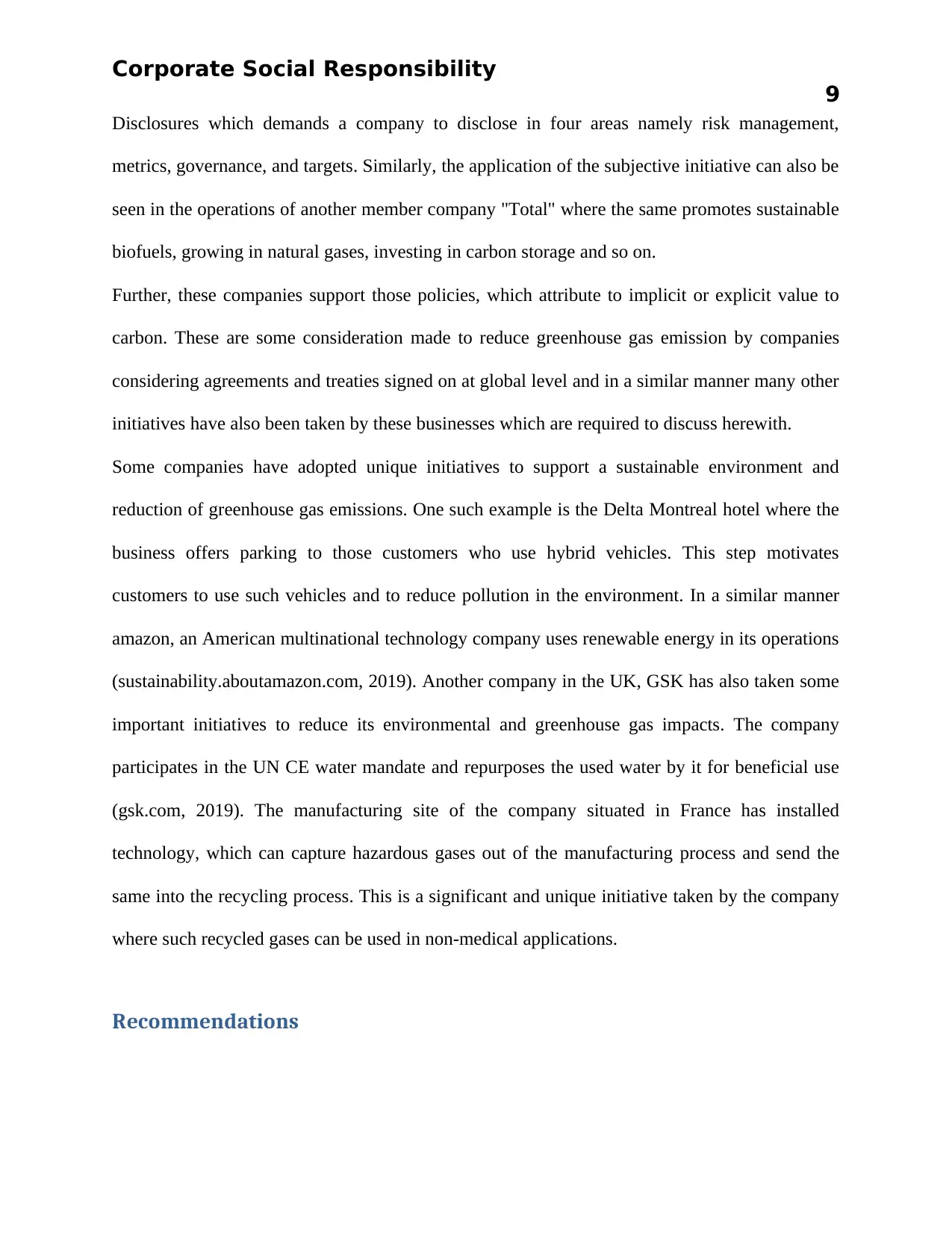
Corporate Social Responsibility
9
Disclosures which demands a company to disclose in four areas namely risk management,
metrics, governance, and targets. Similarly, the application of the subjective initiative can also be
seen in the operations of another member company "Total" where the same promotes sustainable
biofuels, growing in natural gases, investing in carbon storage and so on.
Further, these companies support those policies, which attribute to implicit or explicit value to
carbon. These are some consideration made to reduce greenhouse gas emission by companies
considering agreements and treaties signed on at global level and in a similar manner many other
initiatives have also been taken by these businesses which are required to discuss herewith.
Some companies have adopted unique initiatives to support a sustainable environment and
reduction of greenhouse gas emissions. One such example is the Delta Montreal hotel where the
business offers parking to those customers who use hybrid vehicles. This step motivates
customers to use such vehicles and to reduce pollution in the environment. In a similar manner
amazon, an American multinational technology company uses renewable energy in its operations
(sustainability.aboutamazon.com, 2019). Another company in the UK, GSK has also taken some
important initiatives to reduce its environmental and greenhouse gas impacts. The company
participates in the UN CE water mandate and repurposes the used water by it for beneficial use
(gsk.com, 2019). The manufacturing site of the company situated in France has installed
technology, which can capture hazardous gases out of the manufacturing process and send the
same into the recycling process. This is a significant and unique initiative taken by the company
where such recycled gases can be used in non-medical applications.
Recommendations
9
Disclosures which demands a company to disclose in four areas namely risk management,
metrics, governance, and targets. Similarly, the application of the subjective initiative can also be
seen in the operations of another member company "Total" where the same promotes sustainable
biofuels, growing in natural gases, investing in carbon storage and so on.
Further, these companies support those policies, which attribute to implicit or explicit value to
carbon. These are some consideration made to reduce greenhouse gas emission by companies
considering agreements and treaties signed on at global level and in a similar manner many other
initiatives have also been taken by these businesses which are required to discuss herewith.
Some companies have adopted unique initiatives to support a sustainable environment and
reduction of greenhouse gas emissions. One such example is the Delta Montreal hotel where the
business offers parking to those customers who use hybrid vehicles. This step motivates
customers to use such vehicles and to reduce pollution in the environment. In a similar manner
amazon, an American multinational technology company uses renewable energy in its operations
(sustainability.aboutamazon.com, 2019). Another company in the UK, GSK has also taken some
important initiatives to reduce its environmental and greenhouse gas impacts. The company
participates in the UN CE water mandate and repurposes the used water by it for beneficial use
(gsk.com, 2019). The manufacturing site of the company situated in France has installed
technology, which can capture hazardous gases out of the manufacturing process and send the
same into the recycling process. This is a significant and unique initiative taken by the company
where such recycled gases can be used in non-medical applications.
Recommendations
Paraphrase This Document
Need a fresh take? Get an instant paraphrase of this document with our AI Paraphraser
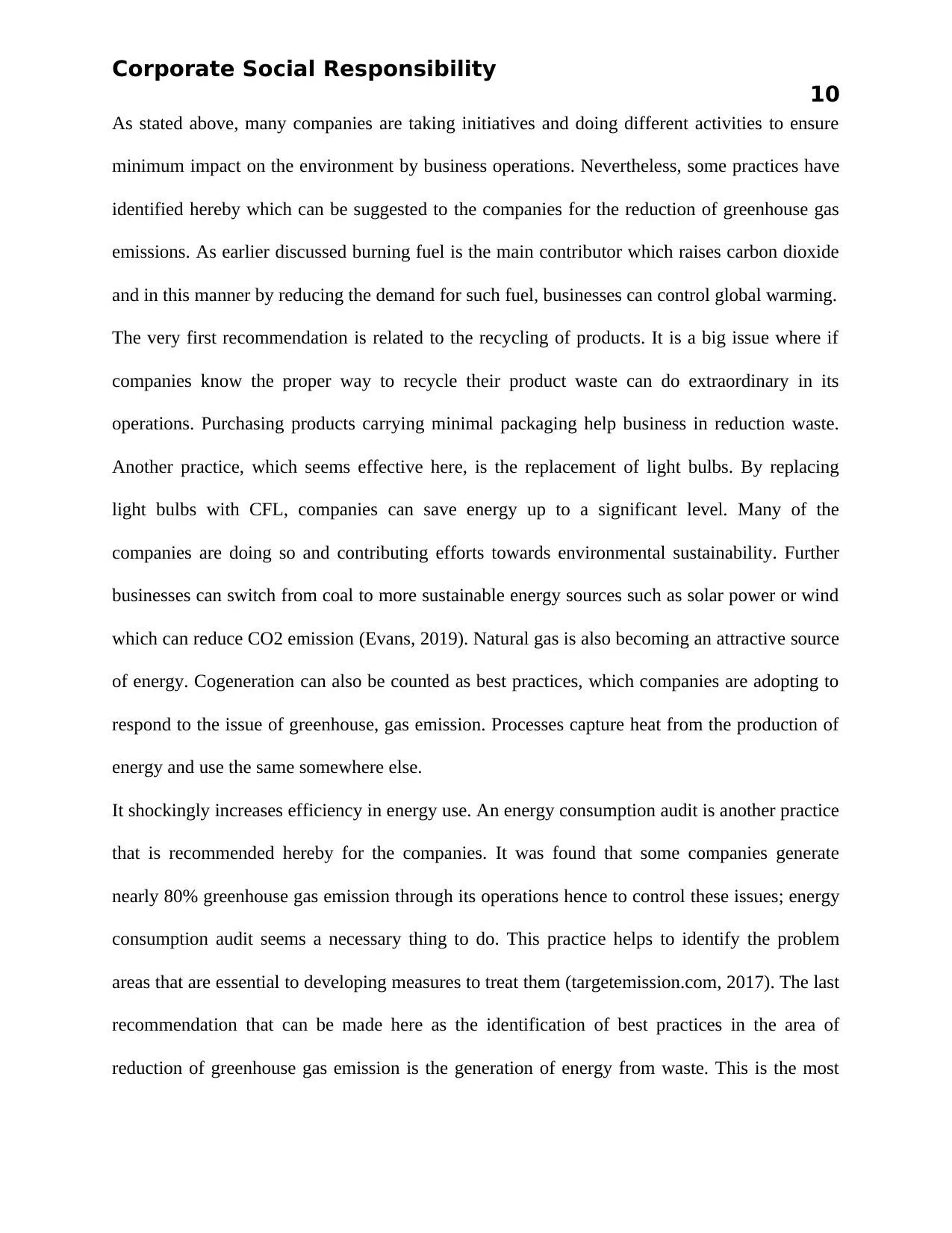
Corporate Social Responsibility
10
As stated above, many companies are taking initiatives and doing different activities to ensure
minimum impact on the environment by business operations. Nevertheless, some practices have
identified hereby which can be suggested to the companies for the reduction of greenhouse gas
emissions. As earlier discussed burning fuel is the main contributor which raises carbon dioxide
and in this manner by reducing the demand for such fuel, businesses can control global warming.
The very first recommendation is related to the recycling of products. It is a big issue where if
companies know the proper way to recycle their product waste can do extraordinary in its
operations. Purchasing products carrying minimal packaging help business in reduction waste.
Another practice, which seems effective here, is the replacement of light bulbs. By replacing
light bulbs with CFL, companies can save energy up to a significant level. Many of the
companies are doing so and contributing efforts towards environmental sustainability. Further
businesses can switch from coal to more sustainable energy sources such as solar power or wind
which can reduce CO2 emission (Evans, 2019). Natural gas is also becoming an attractive source
of energy. Cogeneration can also be counted as best practices, which companies are adopting to
respond to the issue of greenhouse, gas emission. Processes capture heat from the production of
energy and use the same somewhere else.
It shockingly increases efficiency in energy use. An energy consumption audit is another practice
that is recommended hereby for the companies. It was found that some companies generate
nearly 80% greenhouse gas emission through its operations hence to control these issues; energy
consumption audit seems a necessary thing to do. This practice helps to identify the problem
areas that are essential to developing measures to treat them (targetemission.com, 2017). The last
recommendation that can be made here as the identification of best practices in the area of
reduction of greenhouse gas emission is the generation of energy from waste. This is the most
10
As stated above, many companies are taking initiatives and doing different activities to ensure
minimum impact on the environment by business operations. Nevertheless, some practices have
identified hereby which can be suggested to the companies for the reduction of greenhouse gas
emissions. As earlier discussed burning fuel is the main contributor which raises carbon dioxide
and in this manner by reducing the demand for such fuel, businesses can control global warming.
The very first recommendation is related to the recycling of products. It is a big issue where if
companies know the proper way to recycle their product waste can do extraordinary in its
operations. Purchasing products carrying minimal packaging help business in reduction waste.
Another practice, which seems effective here, is the replacement of light bulbs. By replacing
light bulbs with CFL, companies can save energy up to a significant level. Many of the
companies are doing so and contributing efforts towards environmental sustainability. Further
businesses can switch from coal to more sustainable energy sources such as solar power or wind
which can reduce CO2 emission (Evans, 2019). Natural gas is also becoming an attractive source
of energy. Cogeneration can also be counted as best practices, which companies are adopting to
respond to the issue of greenhouse, gas emission. Processes capture heat from the production of
energy and use the same somewhere else.
It shockingly increases efficiency in energy use. An energy consumption audit is another practice
that is recommended hereby for the companies. It was found that some companies generate
nearly 80% greenhouse gas emission through its operations hence to control these issues; energy
consumption audit seems a necessary thing to do. This practice helps to identify the problem
areas that are essential to developing measures to treat them (targetemission.com, 2017). The last
recommendation that can be made here as the identification of best practices in the area of
reduction of greenhouse gas emission is the generation of energy from waste. This is the most
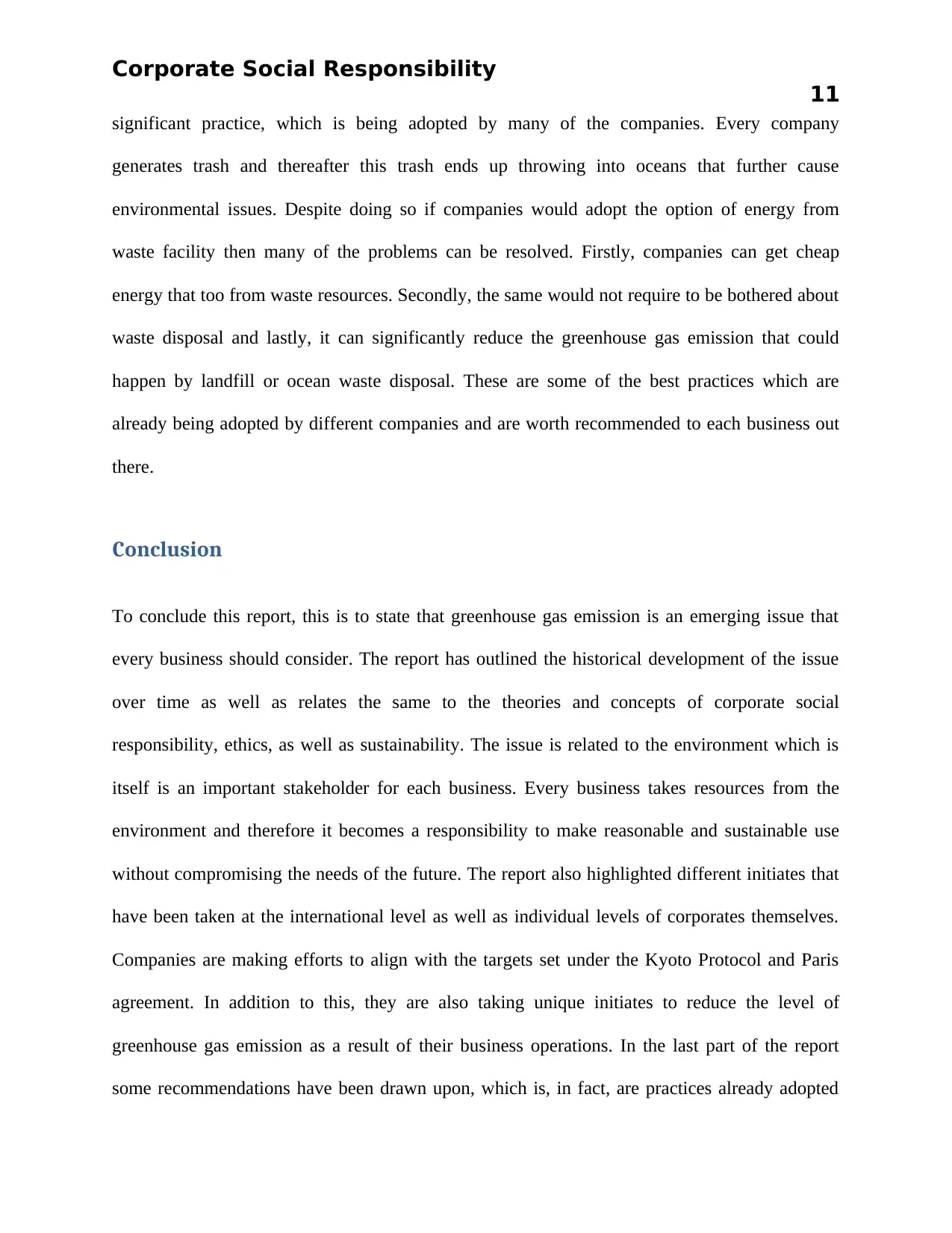
Corporate Social Responsibility
11
significant practice, which is being adopted by many of the companies. Every company
generates trash and thereafter this trash ends up throwing into oceans that further cause
environmental issues. Despite doing so if companies would adopt the option of energy from
waste facility then many of the problems can be resolved. Firstly, companies can get cheap
energy that too from waste resources. Secondly, the same would not require to be bothered about
waste disposal and lastly, it can significantly reduce the greenhouse gas emission that could
happen by landfill or ocean waste disposal. These are some of the best practices which are
already being adopted by different companies and are worth recommended to each business out
there.
Conclusion
To conclude this report, this is to state that greenhouse gas emission is an emerging issue that
every business should consider. The report has outlined the historical development of the issue
over time as well as relates the same to the theories and concepts of corporate social
responsibility, ethics, as well as sustainability. The issue is related to the environment which is
itself is an important stakeholder for each business. Every business takes resources from the
environment and therefore it becomes a responsibility to make reasonable and sustainable use
without compromising the needs of the future. The report also highlighted different initiates that
have been taken at the international level as well as individual levels of corporates themselves.
Companies are making efforts to align with the targets set under the Kyoto Protocol and Paris
agreement. In addition to this, they are also taking unique initiates to reduce the level of
greenhouse gas emission as a result of their business operations. In the last part of the report
some recommendations have been drawn upon, which is, in fact, are practices already adopted
11
significant practice, which is being adopted by many of the companies. Every company
generates trash and thereafter this trash ends up throwing into oceans that further cause
environmental issues. Despite doing so if companies would adopt the option of energy from
waste facility then many of the problems can be resolved. Firstly, companies can get cheap
energy that too from waste resources. Secondly, the same would not require to be bothered about
waste disposal and lastly, it can significantly reduce the greenhouse gas emission that could
happen by landfill or ocean waste disposal. These are some of the best practices which are
already being adopted by different companies and are worth recommended to each business out
there.
Conclusion
To conclude this report, this is to state that greenhouse gas emission is an emerging issue that
every business should consider. The report has outlined the historical development of the issue
over time as well as relates the same to the theories and concepts of corporate social
responsibility, ethics, as well as sustainability. The issue is related to the environment which is
itself is an important stakeholder for each business. Every business takes resources from the
environment and therefore it becomes a responsibility to make reasonable and sustainable use
without compromising the needs of the future. The report also highlighted different initiates that
have been taken at the international level as well as individual levels of corporates themselves.
Companies are making efforts to align with the targets set under the Kyoto Protocol and Paris
agreement. In addition to this, they are also taking unique initiates to reduce the level of
greenhouse gas emission as a result of their business operations. In the last part of the report
some recommendations have been drawn upon, which is, in fact, are practices already adopted
⊘ This is a preview!⊘
Do you want full access?
Subscribe today to unlock all pages.

Trusted by 1+ million students worldwide
1 out of 15
Related Documents
Your All-in-One AI-Powered Toolkit for Academic Success.
+13062052269
info@desklib.com
Available 24*7 on WhatsApp / Email
![[object Object]](/_next/static/media/star-bottom.7253800d.svg)
Unlock your academic potential
Copyright © 2020–2025 A2Z Services. All Rights Reserved. Developed and managed by ZUCOL.





